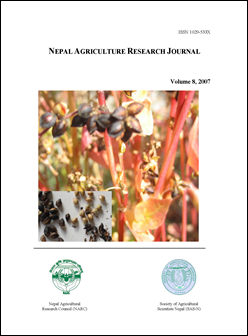Optimization of PCR Conditions for DNA Amplification of Common Buckwheat Using EST Primers
DOI:
https://doi.org/10.3126/narj.v8i0.11563Keywords:
Annealing temperature, Buckwheat, EST markers, Optimization of PCR conditionsAbstract
Under optimal conditions the PCR reaction is very efficient; microgram quantities may be synthesized from a single molecule of substrate DNA. DNA of four lines of common buckwheat (Kyusu, Canada, Miyazaki and Botansoba) was used to optimize PCR reaction and cycling program of 26 primers for DNA amplification of common buckwheat. Annealing temperature (Ta), PCR cycle number and MgCl2 concentration were considered optimum if the single clear band was observed. Of the 26 primers Ta of only 10 primers could be optimized. Three primer pairs performed best at Ta of 54°C. The optimum concentration of MgCl2 was found to be 1.5mM for all primer pairs. Similarly the number of PCR cycles was found to be 40 for all 10 primer pairs except for primer pair 57. Optimized PCR conditions were used for subsequent studies such as transferability of EST primers to other Fagopyrum species and construction of linkage map.
Nepal Agric. Res. J. Vol. 8, 2007, pp. 1-6
Downloads
Downloads
Published
How to Cite
Issue
Section
License
This license allows reusers to copy and distribute the material in any medium or format in unadapted form only, for noncommercial purposes only, and only so long as attribution is given to the creator.




